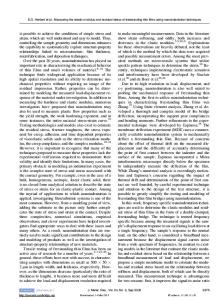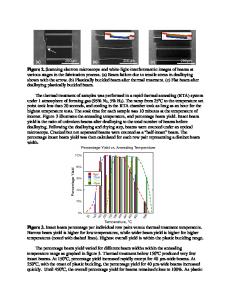Effective Modulus and Stress Relaxation of Freestanding Aluminum Microtensile Beams
- PDF / 307,983 Bytes
- 6 Pages / 612 x 792 pts (letter) Page_size
- 12 Downloads / 355 Views
U10.10.1
Effective Modulus and Stress Relaxation of Freestanding Aluminum Microtensile Beams P. A. El-Deiry, N. Barbosa III, W. L. Brown, R. P. Vinci Department of Materials Science and Engineering, Lehigh University, Bethlehem, PA, USA ABSTRACT Freestanding Al thin film microtensile beams 600 µm long, 100 µm wide, and with thicknesses of 0.25 µm, 0.50 µm, 0.75 µm, and 1.00 µm were tested under uniaxial tension with a custom-built microtensile system. Displacement controlled experiments employing five strain rates between 8.3 x 10-4 s-1 and 8.3 x 10-1 s-1 were performed. Three crosshead displacements of 1.00 µm (0.17% strain), 2.60 µm (0.43%), and 3.60 µm (0.60% strain) were exercised in order to investigate behavior in the elastic, anelastic, and the inelastic sections of the stress/strain curve. At a 0.17% strain amplitude, the 0.50 µm thick microtensile beams exhibit an effective modulus that increases with increasing strain rate. The 1.00 µm, 0.75 µm, and 0.25 µm microtensile beams do not show a similar trend. The 0.25 µm and the 0.75 µm thick microtensile beams have similar grain sizes and similar moduli; the 0.50 µm and the 1.00 µm microtensile beams have similar but smaller grain sizes and higher effective moduli. This suggests that grain size is more significant than film thickness in determining the effective modulus of freestanding Al thin films. Furthermore, no stress relaxation behavior was identified for any of the films during the hold at the 0.17% strain amplitude. At a strain amplitude of 0.43%, the effective moduli are very similar to the values measured at a 0.17% strain amplitude; however, the 0.50 µm and 1.00 µm thick microtensile beams show measurable stress relaxation while the 0.25 µm and 0.75 µm microtensile beams do not. This result combined with a lower observed modulus suggests that the particular anelastic mechanisms operating in these films at these time scales activate sooner and provide a faster stress relaxation process in the larger grained films. INTRODUCTION In 1967 with the design and fabrication of the resonant gate structure by Nathanson, Newell, Wickstrom, and Davis Jr. at Westinghouse Research Laboratories located in Pittsburgh, PA, microelectromechanical systems (MEMS) became a reality.1 MEMS rely on the movement and interactions of extremely small pieces of three dimensional structures primarily constructed with thin films. Operation of a MEMS depends on the precision and repeatability of motion for these tiny pieces of metal and semiconductor. For example, if an aluminum hinge for a micromirror device undergoes plastic deformation (i.e. at 2.0% strain) in cycle one of one hundred, then in the following ninety-nine cycles the device may not operate as desired. On the other hand, if the strain is 0.05%, then the device may behave perfectly elastically and operate as desired for billions of cycles. However, if the first cycle applies a strain of 0.50%, the metal may show signs of anelasticity, and the remaining cycles may not behave like the first. Anelastic deformation is an
Data Loading...











